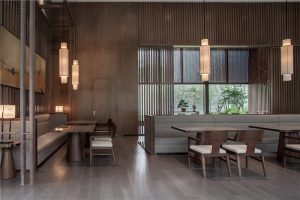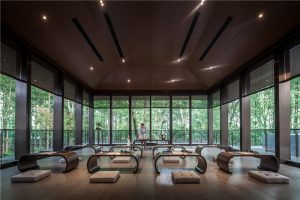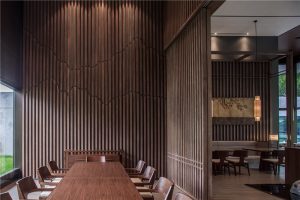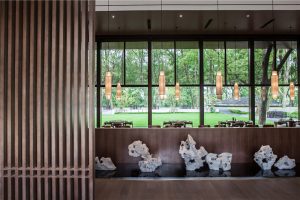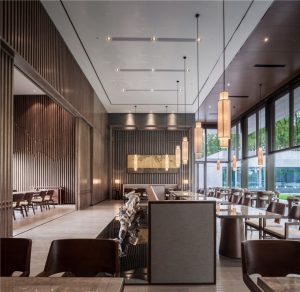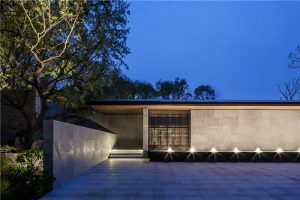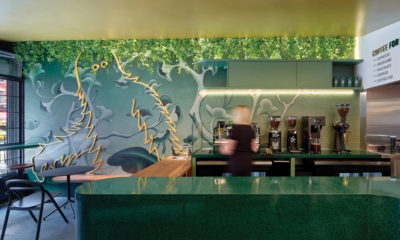Taohuayuan means “utopia” in the Chinese Mandarin dialect.
In fact, a home by that name in Souzhou, west of Shanghai, was the most expensive ever to hit the market in mainland China (one billion Chinese yuan, the equivalent of $154 million) when it was completed in 2016.
CL3 Architect’s view of utopia is considerably more simplified. The Hong Kong-based design firm has created an homage to the tea culture of China with the Tao Hua Yuan tea house in Nanjing, using a quiet Zen aesthetic and a simple style to bring tranquility in a bustling urban and resort area.
The architecture tells much of the story: a contemporary structure using flat planes, right angles, lots of glass and open areas. “The architecture is inspired by a Chinese courtyard house, with a series of enclosed spaces formed around open spaces and connected by covered walkways,” says William Lim, managing director of the firm. “The building is in a clear outline of single rectangles, tucked away in the forest like a masterpiece of nature.”
But if the architecture is contemporary, it’s the materials – marble and glass, but also wood and bamboo – that tell the Zen story, a harmonious combination of hard and soft.
“The marble is strong and steady, the glass is clear and pure,” says Lim. “The interior becomes the extension of the architecture – simple materials and concise lines to create Zen tranquility.”
Advertisement
Inside, lanterns, paintings and works of art express the “one-with-nature” story, along with what Lim calls “scholar rocks.”
“Scholar rocks are massive rocks recovered from river beds with naturally eroded holes and wrinkles,” he explains. “Six massive rocks sit on a platform of black mirror, simulating water reflection. This serves as a piece of art installation, as well as dividing the teahouse into semi-private zones. The verticality of the young forest is reinforced by the vertical lines in the interior design in the background of black glass.”
Symbolic Chinese culture is never far from the designers’ thinking. For example, custom-designed furniture and lighting reflect the importance of balance in Chinese style. Low-rise furniture – the kinds that prevailed in ancient times when people tended to sit on the floor – is matched with modern high-type furniture. “They are mainly made of wood and are in simple colors,” Lim says, “containing both classical charm and fresh ideas, giving a contemporary interpretation to the Chinese cultural heritage.”
Creating the appropriate tea house is not a casual endeavor in a culture where tea commands such an important position. “Tea absorbs the spirit of the universe,” says Lim, “appealing to men of letters throughout the ages.”
Photography: Nirut Benjabanpot, Hong Kong
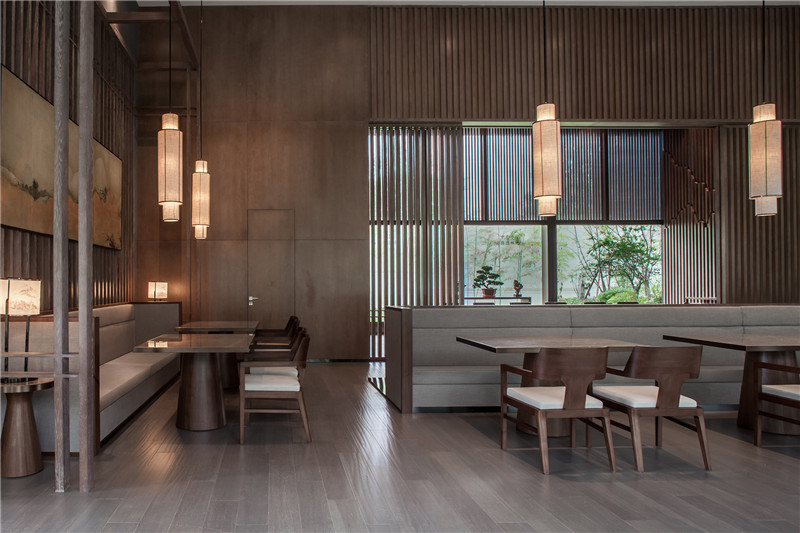

 Headlines6 days ago
Headlines6 days ago
 Headlines2 weeks ago
Headlines2 weeks ago
 Headlines1 week ago
Headlines1 week ago
 Headlines2 weeks ago
Headlines2 weeks ago
 John Ryan2 weeks ago
John Ryan2 weeks ago
 Headlines2 weeks ago
Headlines2 weeks ago
 Sector Spotlight1 week ago
Sector Spotlight1 week ago
 Headlines2 weeks ago
Headlines2 weeks ago
